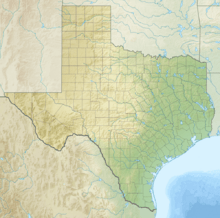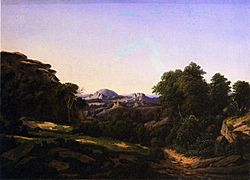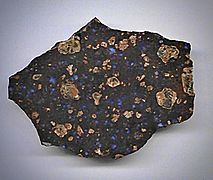Llano Uplift facts for kids
Quick facts for kids Llano Uplift |
|
|---|---|
| Geography | |
| State/Province | Texas Hill Country |
| County | Llano County, Texas |
| Municipality | Llano, Texas |
| Range coordinates | 30°10′27″N 99°03′55″W / 30.17417°N 99.06528°W |
| Geology | |
| Orogeny | Grenville orogeny |
| Age of rock | Mesoproterozoic |
| Type of rock | Precambrian and Paleozoic inlier surrounded by Cretaceous uplands. |
The Llano Uplift is a very old, gently rounded area of land in Texas. It's like a large, low dome about 90 miles (145 km) wide. You can find it mostly in Llano, Mason, San Saba, Gillespie, and Blanco counties.
This area is special because it has an "island" of very ancient rocks. These rocks are Precambrian igneous (formed from cooled magma) and metamorphic (changed by heat and pressure). Younger rocks from the Paleozoic and Cretaceous eras surround this ancient core. The oldest exposed rocks stretch about 65 miles (105 km) west from the Colorado River valley.
The Llano Uplift is famous for its large, rounded granite domes, like Enchanted Rock. Many rock quarries, such as Granite Mountain, mine the unique pink granite found here. Also, this area is the only place where a special rock called llanite has been found. In 1992, the Texas Department of Health noted this region as having a higher chance of radon gas presence.
Contents
What is the Llano Uplift?
The Llano Uplift is a geological feature that looks like a raised area on a map of rocks. It's considered an "uplift" because its very old Precambrian rocks are much higher than the surrounding rocks. However, it might not have been lifted up all at once. Instead, it formed over a long time. The areas around it sank, and the Precambrian rocks underneath were pushed up by different geological forces at various times, especially during the Carboniferous and Cretaceous periods.
The Oldest Rocks: Precambrian
The very oldest rocks in the Llano Uplift are Precambrian rocks. They are found in the lowest part of the area, in a basin drained by the Llano River and extending to the Colorado River. These rocks are about 900,000 square kilometers (347,492 sq mi) of ancient crystalline basement rock. They are exposed because younger layers of rock have been eroded away, creating a "window" to these older layers.
These Precambrian rocks are between 1.37 and 1.23 billion years old. They include rocks that have been changed by heat and pressure (metamorphic) and rocks that formed from cooled magma (igneous). Later, even younger granite rocks pushed into them. These rocks were formed and moved around during a huge event called the Grenville orogeny, which was a time of continental collision and mountain formation. After this, erosion wore down several kilometers of these rocks over 400 million years.
Younger Rocks: Lower Paleozoic (Cambrian and Ordovician)
Around and within the Llano Uplift, you can find younger Paleozoic rocks. These rocks often form noticeable hills. They include over 600 meters (1,969 ft) of Cambrian sandstones and limestones, and Ordovician limestones.
These rocks tell a story of ancient seas. During the Middle to Late Cambrian period, a sea slowly spread from the southeast over the eroded Precambrian rocks. As the sea advanced, it left behind layers of sand, limestone, and other sediments. Later, in the Early Ordovician, more limestones formed in shallow ocean areas. After this, the land tilted, and these rocks were exposed to air and karstification (where water dissolves rock, creating caves and sinkholes).
Some evidence suggests that the Llano Uplift area might have been briefly covered by sea again during the Middle and Upper Ordovician periods, but any sediments from that time were mostly washed away.
Middle Paleozoic (Silurian and Devonian)
Rocks from the Silurian and Devonian periods are also found in the Llano Uplift. However, they are not widespread. Instead, they are preserved in small pockets, like the fillings of ancient sinkholes or cracks in the older rocks. These small deposits show that the Llano region was covered by sea at least a few times during these periods. But during long periods when the land was exposed, most of these younger sediments were eroded away.
Late Paleozoic (Carboniferous and Permian)
Similar to the Devonian rocks, early Carboniferous rocks are mostly found in small amounts within ancient sinkholes and other karst features. This means the area was briefly covered by shallow seas, followed by long periods of land exposure where erosion removed most of the marine sediments.
Later Carboniferous rocks are found in three main areas. These rocks show how the nearby Fort Worth Basin deepened and filled with sediments from rivers and deltas. This happened as the Ouachita Orogeny (another mountain-building event) pushed up mountains to the east.
Mesozoic Era
The only Mesozoic rocks found in the Llano region are from the Cretaceous period. During the Triassic and Jurassic periods, the Llano region was mostly eroded.
By the time the Llano Uplift was slowly covered by Cretaceous sediments, it had been worn down to a relatively flat surface. This surface was then buried by layers of river and coastal sediments.
Cenozoic Era
Since the Cretaceous seas pulled back, erosion has continued to shape the land. Interestingly, the oldest rocks in the Llano Uplift often appear at the lowest elevations today. Where the younger Cretaceous rocks surround the uplift, you can often see a sharp rise in the land, like a cliff or escarpment.
Central Mineral Region
The Llano Uplift is also known as the Central Mineral Region of Texas. This is because a wide variety of minerals have been found here. Over the years, small mines have produced minerals like yttrium and other rare-earth minerals, magnetite, feldspar, and even gem-quality topaz. There have also been small amounts of gold, silver, copper, and other metals found.
Before it closed in 1980, the Southwestern Graphite mine near Burnet, Texas, was a major producer of high-purity graphite in North America. In the past, large amounts of soapstone were dug up and used in various products. Today, the main mineral resources produced from this region are fracturing sand, crushed stone, and building stone. Granite is still quarried from many places, including a large pink granite dome near Marble Falls, Texas.
- Llano uplift context and features
Images for kids







